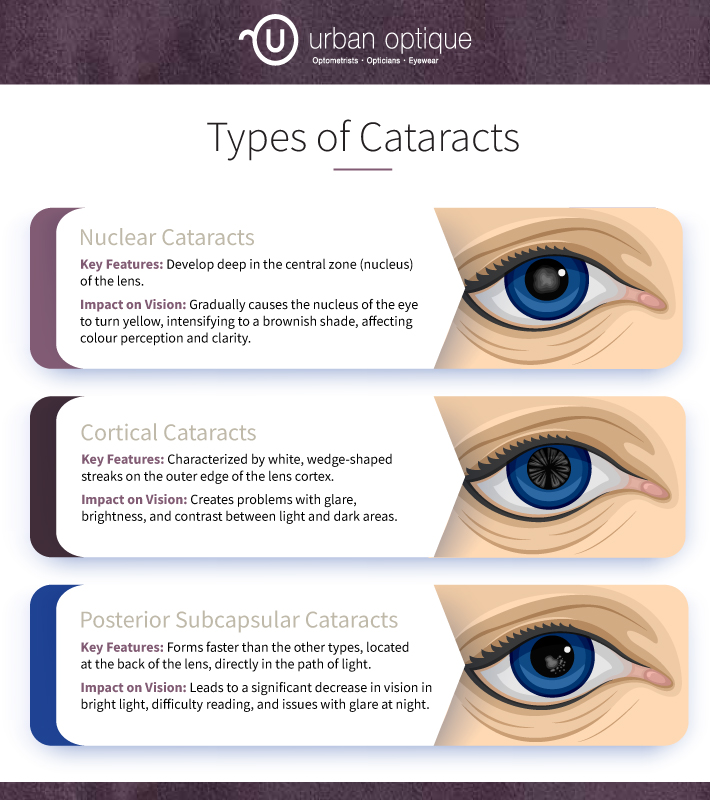Cataracts is a vision condition that often accompanies aging. However, they’re not just an ailment confined to older adults. Understanding the nuances and the various forms cataracts can take is pivotal to taking proactive steps to maintain a clear and healthy vision for a lifetime.
The 3 main types of cataracts include the nuclear sclerotic, cortical, and posterior subcapsular. Each cataract type has unique symptoms and impacts vision differently. An eye care professional can conduct a comprehensive exam to determine which form you may have and then formulate a targeted approach to treatment and management.
Understanding the World of Cataracts
Cataracts are among the most common causes of vision loss worldwide, and they manifest as a clouding of the lens within your eye, leading to a decline in vision quality.
The condition often develops slowly and may not initially affect your sight. Still, as it progresses, you may experience blurred vision, sensitivity to light, double vision, and an increased need for brighter light for reading and other activities. Left untreated, cataracts can profoundly impact daily life, making driving, reading, or even recognizing faces difficult.
Early detection is crucial because cataracts can be managed effectively, especially when identified before they significantly interfere with your life. Cataract removal surgery is one of the most common surgeries and is a safe and effective procedure for restoring vision.

Types of Cataracts & Their Distinctive Features
Understanding the types of cataracts is essential to fully appreciating their implications. Each of the 3 main types has a unique set of symptoms and causes.
Nuclear Sclerotic Cataracts
Nuclear sclerotic cataracts are the most common type and are typically associated with aging. They form in the lens’s central zone (the nucleus) and slowly harden and darken over time.
People with nuclear cataracts often experience a gradual reduction in vision, increased nearsightedness, and improved reading vision, which eventually culminates in a brownish or yellowish tint to their vision.
Symptoms & Causes
The primary symptoms of nuclear cataracts include:
- The need for brighter light for reading and other ordinary tasks
- The perception that there is a film over the eyes
- Problems identifying colours
Nuclear cataracts develop due to the natural aging process and are not preventable.
Cortical Cataracts
Cortical cataracts occur on the lens cortex, which is the part of the lens that surrounds the central nucleus. They initially manifest as white, wedge-like opacities that start on the outer edge of the lens and work their way to the center.
Symptoms & Causes
With cortical cataracts, you may experience:
- Glare and haloes around lights, especially at night
- Difficulty with contrast vision
- Light points appear more intense in the dark
- A milky appearance when looking through the central part of the lens
Prolonged exposure to UV radiation from sunlight, diabetes, and the use of corticosteroid medications are risk factors for cortical cataracts.
Posterior Subcapsular Cataracts
Posterior subcapsular cataracts develop at the back of the lens, directly underneath the capsule, a sac that encases the lens.
Symptoms & Causes
Symptoms can include:
- Glare and haloes around lights, especially when you’re driving at night
- Reading vision deteriorating faster than usual
- Sensitivity to light
This type is often seen more in younger people. It is associated with high myopia, steroid use, and trauma to the eye.
Diagnosing the Culprit Behind Clouded Vision
A professional eye exam can diagnose cataracts early. During your exam, your eye doctor will perform a series of tests to determine your cataracts’ size, location, type, and severity. These tests may include a visual acuity test, a dilated eye exam, and other eye health evaluations.
Early Detection: A Sight-Saving Practice
Even if they aren’t experiencing vision problems, adults aged 65 or older should get a comprehensive eye exam at least once yearly to check for cataracts and other eye conditions.
Treatment Options for Cataracts
Treatment for cataracts depends on the stage of development and the impact on your quality of life. In the early stages, vision aids such as glasses and improved lighting might be enough.
However, as cataracts progress and begin to interfere significantly with daily activities, surgery to remove the cloudy lens and replace it with an artificial one—called an intraocular lens—is usually the most effective treatment.
Cataract surgery is quick, essentially painless, and has a very high success rate. Newer, more advanced lenses can also correct astigmatism and reduce the need for reading glasses, offering improved vision beyond cataract removal.
Nonsurgical Management
If cataracts are diagnosed in the early stages, there are some noninvasive ways to manage the symptoms, including:
- Using brighter lights for reading and other activities
- Anti-glare sunglasses
- Magnifying lenses and glasses
- Regular eye checkups to monitor the progression of cataracts
Lifestyle Adjustments & Preventive Measures
While some factors leading to cataracts, such as aging and genetic predisposition, are beyond your control, there are lifestyle changes that can help manage the condition and reduce the risk of developing cataracts.
Preventive Measures
- Protect your eyes from UVB radiation by wearing sunglasses with UVA/UVB protection.
- Eat a diet rich in antioxidants, particularly vitamins C and E, in fruits and vegetables.
- Avoid smoking and excessive alcohol consumption.
- Maintain overall health, including controlling chronic diseases like diabetes.
Living with Cataracts
If you have been diagnosed with cataracts, there are ways to manage the condition and its symptoms:
- Regular checkups with your eye doctor
- Use of proper eyewear with anti-reflective coatings
- Making environmental changes, such as using task lighting or anti-glare products

Restore Your Visual Clarity
Cataracts may seem unavoidable in the aging process, but understanding the different types, recognizing the symptoms, and knowing your treatment options can make a difference in managing this condition. By prioritizing regular eye exams, adopting healthy lifestyle practices, and being aware of the available treatments, you can safeguard your vision and enjoy a clear and vibrant world for years to come. Feel free to consult with a professional at Urban Optique for personalized guidance. Remember, clear vision is not merely a luxury but a fundamental aspect of living your best life.
















